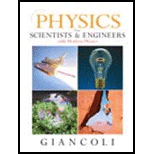
Physics for Scientists and Engineers with Modern Physics
4th Edition
ISBN: 9780136139225
Author: Douglas C. Giancoli
Publisher: Prentice Hall
expand_more
expand_more
format_list_bulleted
Concept explainers
Question
Chapter 43, Problem 1Q
To determine
The reaction between two nucleons that could produce a
Expert Solution & Answer
Answer to Problem 1Q
The reaction between two nucleons that could produce a
Explanation of Solution
Nucleons are the particles found in nucleus of an atom. Protons and the neutrons are the nucleons because they are in the nucleus of an atom. The proton is having positive charge and neutron does not have any charge. The proton and neutron are both baryon and fermions.
Write the expression for reaction between two nucleons.
Here,
Conclusion:
Therefore, the reaction between two nucleons that could produce a
Want to see more full solutions like this?
Subscribe now to access step-by-step solutions to millions of textbook problems written by subject matter experts!
Students have asked these similar questions
Can someone help me with this question. Thanks.
Can someone help me with this question. Thanks.
Can someone help me with this question. Thanks.
Chapter 43 Solutions
Physics for Scientists and Engineers with Modern Physics
Ch. 43.1 - Prob. 1AECh. 43.2 - Prob. 1CECh. 43.9 - Prob. 1DECh. 43.9 - Prob. 1EECh. 43 - Prob. 1QCh. 43 - If a proton is moving at very high speed, so that...Ch. 43 - Prob. 3QCh. 43 - Prob. 4QCh. 43 - Prob. 5QCh. 43 - Prob. 6Q
Ch. 43 - Prob. 7QCh. 43 - Prob. 8QCh. 43 - Prob. 9QCh. 43 - Prob. 10QCh. 43 - Prob. 11QCh. 43 - Prob. 12QCh. 43 - Prob. 13QCh. 43 - Prob. 14QCh. 43 - Prob. 15QCh. 43 - Prob. 16QCh. 43 - Prob. 17QCh. 43 - Prob. 18QCh. 43 - Prob. 19QCh. 43 - Prob. 20QCh. 43 - Prob. 1PCh. 43 - Prob. 2PCh. 43 - Prob. 3PCh. 43 - Prob. 4PCh. 43 - Prob. 5PCh. 43 - Prob. 6PCh. 43 - Prob. 7PCh. 43 - Prob. 8PCh. 43 - Prob. 9PCh. 43 - Prob. 10PCh. 43 - Prob. 11PCh. 43 - Prob. 12PCh. 43 - Prob. 13PCh. 43 - Prob. 14PCh. 43 - Prob. 15PCh. 43 - Prob. 16PCh. 43 - Prob. 17PCh. 43 - Prob. 18PCh. 43 - Prob. 19PCh. 43 - Prob. 20PCh. 43 - Prob. 21PCh. 43 - Prob. 22PCh. 43 - Prob. 23PCh. 43 - Prob. 24PCh. 43 - Prob. 25PCh. 43 - Prob. 26PCh. 43 - Prob. 27PCh. 43 - Prob. 28PCh. 43 - Prob. 29PCh. 43 - Prob. 30PCh. 43 - Prob. 31PCh. 43 - Prob. 32PCh. 43 - Prob. 33PCh. 43 - Prob. 34PCh. 43 - Prob. 35PCh. 43 - Prob. 36PCh. 43 - Prob. 37PCh. 43 - Prob. 38PCh. 43 - Prob. 39PCh. 43 - Prob. 40PCh. 43 - Prob. 41PCh. 43 - Prob. 42PCh. 43 - Prob. 43PCh. 43 - Prob. 44PCh. 43 - Prob. 45PCh. 43 - Prob. 46GPCh. 43 - Prob. 47GPCh. 43 - Prob. 48GPCh. 43 - Prob. 49GPCh. 43 - Prob. 50GPCh. 43 - Prob. 51GPCh. 43 - Prob. 52GPCh. 43 - Prob. 53GPCh. 43 - Prob. 54GPCh. 43 - Prob. 55GPCh. 43 - Prob. 56GPCh. 43 - Prob. 57GPCh. 43 - Prob. 58GPCh. 43 - Prob. 59GPCh. 43 - Prob. 60GPCh. 43 - Prob. 61GPCh. 43 - Prob. 62GPCh. 43 - Prob. 63GPCh. 43 - Prob. 64GPCh. 43 - What fraction of the speed of light c is the speed...Ch. 43 - Prob. 66GPCh. 43 - Prob. 67GP
Knowledge Booster
Learn more about
Need a deep-dive on the concept behind this application? Look no further. Learn more about this topic, physics and related others by exploring similar questions and additional content below.Similar questions
- Identical rays of light enter three transparent blocks composed of different materials. Light slows down upon entering the blocks.arrow_forwardFor single-slit diffraction, calculate the first three values of (the total phase difference between rays from each edge of the slit) that produce subsidiary maxima by a) using the phasor model, b) setting dr = 0, where I is given by, I = Io (sin (10) ². 2arrow_forwardA capacitor with a capacitance of C = 5.95×10−5 F is charged by connecting it to a 12.5 −V battery. The capacitor is then disconnected from the battery and connected across an inductor with an inductance of L = 1.55 H . (D)What is the charge on the capacitor 0.0235 s after the connection to the inductor is made? Interpret the sign of your answer. (e) At the time given in part (d), what is the current in the inductor? Interpret the sign of your answer. (f) Atthe time given in part (d), how much electrical energy is stored in the capacitor and how much is stored in the inductor?arrow_forward
arrow_back_ios
SEE MORE QUESTIONS
arrow_forward_ios
Recommended textbooks for you
 College PhysicsPhysicsISBN:9781938168000Author:Paul Peter Urone, Roger HinrichsPublisher:OpenStax College
College PhysicsPhysicsISBN:9781938168000Author:Paul Peter Urone, Roger HinrichsPublisher:OpenStax College Modern PhysicsPhysicsISBN:9781111794378Author:Raymond A. Serway, Clement J. Moses, Curt A. MoyerPublisher:Cengage Learning
Modern PhysicsPhysicsISBN:9781111794378Author:Raymond A. Serway, Clement J. Moses, Curt A. MoyerPublisher:Cengage Learning Principles of Physics: A Calculus-Based TextPhysicsISBN:9781133104261Author:Raymond A. Serway, John W. JewettPublisher:Cengage Learning
Principles of Physics: A Calculus-Based TextPhysicsISBN:9781133104261Author:Raymond A. Serway, John W. JewettPublisher:Cengage Learning College PhysicsPhysicsISBN:9781305952300Author:Raymond A. Serway, Chris VuillePublisher:Cengage Learning
College PhysicsPhysicsISBN:9781305952300Author:Raymond A. Serway, Chris VuillePublisher:Cengage Learning College PhysicsPhysicsISBN:9781285737027Author:Raymond A. Serway, Chris VuillePublisher:Cengage Learning
College PhysicsPhysicsISBN:9781285737027Author:Raymond A. Serway, Chris VuillePublisher:Cengage Learning University Physics Volume 3PhysicsISBN:9781938168185Author:William Moebs, Jeff SannyPublisher:OpenStax
University Physics Volume 3PhysicsISBN:9781938168185Author:William Moebs, Jeff SannyPublisher:OpenStax

College Physics
Physics
ISBN:9781938168000
Author:Paul Peter Urone, Roger Hinrichs
Publisher:OpenStax College

Modern Physics
Physics
ISBN:9781111794378
Author:Raymond A. Serway, Clement J. Moses, Curt A. Moyer
Publisher:Cengage Learning

Principles of Physics: A Calculus-Based Text
Physics
ISBN:9781133104261
Author:Raymond A. Serway, John W. Jewett
Publisher:Cengage Learning

College Physics
Physics
ISBN:9781305952300
Author:Raymond A. Serway, Chris Vuille
Publisher:Cengage Learning

College Physics
Physics
ISBN:9781285737027
Author:Raymond A. Serway, Chris Vuille
Publisher:Cengage Learning

University Physics Volume 3
Physics
ISBN:9781938168185
Author:William Moebs, Jeff Sanny
Publisher:OpenStax